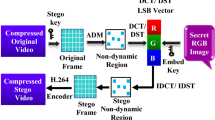Abstract
In H.265/HEVC, high occupancy rates in bitstreams indicate DCT/DST residual coefficients are ideal embedding positions for video steganography. This paper presents a novel hybrid video steganography embedding framework based on DCT/DST residual coefficients. For intra-prediction, 4 × 4 DST residual coefficients are selected as embedding carrier for high imperceptibility, intra-prediction modes and coefficient pairs are used for averting intra distortion drift and improving visual quality of stego video. For inter-prediction, 4 × 4 DCT residual coefficients and N-dimensional space coding are used for limiting inter-embedding error, where the superiority is that we can embed multiple bits of secret message while only one 4 × 4 DCT residual coefficient needs to be modified at most, where the high visual quality and low bit-rate increase can be achieved. The proposed embedding framework combines the advantages of the technique of intra-averting distortion drift and inter-N-dimensional space coding of DCT residual coefficients to an integrated solution, where increasing the embedding capacity significantly. The experimental results have been proven the superiority of the proposed video steganography embedding framework in terms of high visual quality, high embedding capacity and low bit rate increase.
Access this chapter
Tax calculation will be finalised at checkout
Purchases are for personal use only
Similar content being viewed by others
References
Liu, Y.X., Liu, S., Wang, Y.H., Zhao, H.G.: Video coding and processing: a survey. Neurocomputing 408, 331–344 (2020)
Liu, Y.X., Liu, S.Y., Wang, Y.H., Zhao, H.G., et al.: Video steganography: a review. Neurocomputing 335(2019), 238–250 (2019)
Kunhoth, J., et al.: Video steganography: recent advances and challenges. Multimedia Tools Appl. 82.27, 41943–41985 (2023)
Sullivan, G.J., Ohm, J.R., Han, W.J., Wiegand, T.: Overview of the high efficiency video coding (HEVC) standard. IEEE Trans. Circuits Syst. Video Technol. 22(12), 1649–1668 (2012)
Wang, J.J.: An information hiding algorithm for HEVC based on angle differences of intra prediction mode. J. Softw. 10(2), 213–221 (2015)
Yao, Y.Z., Zhang, W.M., Yu, N.H., et al.: Defining embedding distortion for motion vector-based video steganography. Multimedia Tools Appl. 74(24), 11163–11186 (2015)
Xu, D.W., Wang, R.D., Shi, Y.Q.: Data hiding in encrypted H.264/AVC video streams by codeword substitution. IEEE Trans. Inf. Forensics Secur. 9(4), 596–606 (2014)
Ma, X.J., Li, Z.T., Tu, H., et al.: A data hiding algorithm for H. 264/AVC video streams without intra-frame distortion drift. IEEE Trans. Circ. Syst. Video Technol. 20(10), 1320–1330 (2010)
Liu, Y.X., Zhao, H.G., Liu, S.Y., et al.: A robust and improved visual quality data hiding method for HEVC. IEEE Access. 6, 53984–53987 (2018)
Liu, Y.X., Li, Z.T., Ma, X.J., Liu, J.: A robust without intra-frame distortion drift data hiding algorithm based on H.264/AVC. Multimedia Tools Appl. 72(1), 613–636 (2014)
Liu, Y., Jia, S., Hu, M., et al.: A reversible data hiding method for H.264 with Shamir’s (t, n)-threshold secret sharing. Neurocomputing 188, 63–70 (2016)
Swati, S., Khizar, H., Zafar, S.: A watermarking scheme for high efficiency video coding (HEVC). PLoS ONE 9(8), e105613 (2014)
Yang, J., Li, S.B.: An efficient information hiding method based on motion vector space encoding for HEVC. Multimedia Tools Appl. 77, 11979–12001 (2018). https://doi.org/10.1007/s11042-017-4844-1
Liu, Y.X., Liu, S.Y., Zhao, H.G., et al.: A new data hiding method for H.265/HEVC video streams without intra-frame distortion drift. Multimedia Tools and Applications 78, 6459–6486 (2019)
Zhao, H.G., Liu, Y.X., Wang, Y.H., et al.: A video steganography method based on transform block decision for H.265/HEVC. IEEE Access. 9, 55506–55521 (2021). https://doi.org/10.1109/ACCESS.2021.3059654
Zhao, H.G., Liu, Y.X., Wang. Y.H.: A novel two-dimensional histogram shifting video steganography algorithm for video protection in H.265/HEVC. In: Intelligent Computing Methodologies: 18th International Conference, ICIC 2022, Xi’an, China, August 7–11, 2022, Proceedings, Part III. Springer International Publishing, Cham (2022). https://doi.org/10.1007/978-3-031-13832-4_55
Zhao, H.G., et al.: Using N-dimensional space coding of transform coefficients for video steganography in H.265/HEVC. In: International Conference on Intelligent Computing. Springer Nature Singapore, Singapore (2023). https://doi.org/10.1007/978-3-031-13832-4_55
Acknowledgment
This paper is sponsored by Henan International Joint Laboratory of Blockchain and Audio/Video Security, Henan Big Data Security and Privacy Development Innovation Laboratory, Zhengzhou Key Laboratory of Blockchain and CyberSecurity, and 2023 Henan Science&Technology Breakthrough project, “Research on Covert Communication Based on H.265 Video Steganography” (No. 232102210126).
Author information
Authors and Affiliations
Corresponding author
Editor information
Editors and Affiliations
Rights and permissions
Copyright information
© 2024 The Author(s), under exclusive license to Springer Nature Singapore Pte Ltd.
About this paper
Cite this paper
Zhao, H., Liu, Y., Liu, H., Zheng, Y., Liu, S., Fang, H. (2024). A Hybrid DCT/DST Based Embedding Framework for Video Steganography in H.265/HEVC. In: Huang, DS., Zhang, C., Guo, J. (eds) Advanced Intelligent Computing Technology and Applications. ICIC 2024. Lecture Notes in Computer Science, vol 14871. Springer, Singapore. https://doi.org/10.1007/978-981-97-5609-4_6
Download citation
DOI: https://doi.org/10.1007/978-981-97-5609-4_6
Published:
Publisher Name: Springer, Singapore
Print ISBN: 978-981-97-5608-7
Online ISBN: 978-981-97-5609-4
eBook Packages: Computer ScienceComputer Science (R0)




